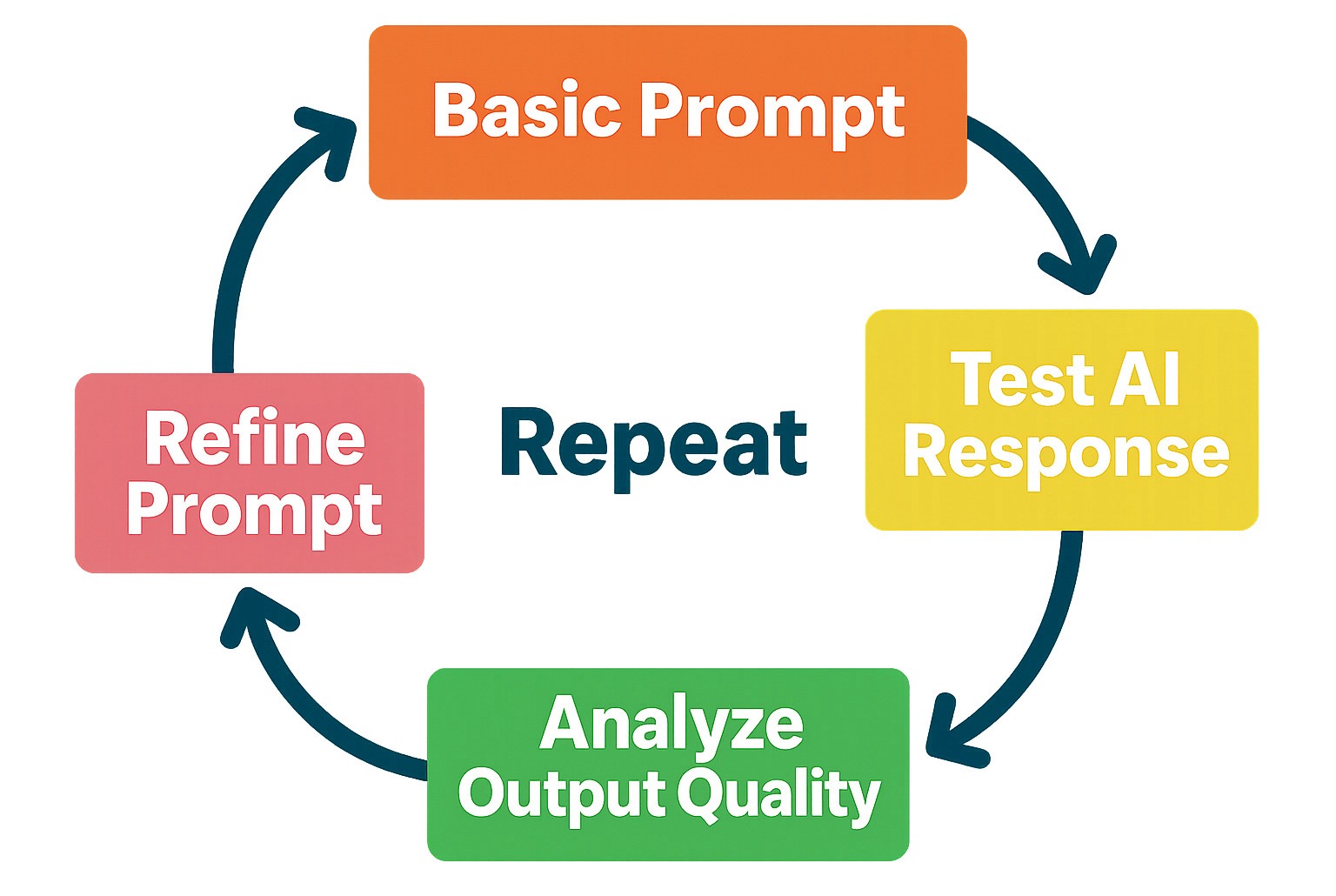Prompt Engineering: Where to Learn and Grow
Why Prompt Engineering Resources Are Essential for AI Success.

Prompt engineering resources are your gateway to opening up the full potential of AI tools like ChatGPT, Claude, and GPT-4. As the field grows, knowing where to find quality learning materials is crucial for anyone working with AI.
Quick Resource Categories:
- Learning Platforms: Free courses from Learn Prompting, DeepLearning.AI, and DAIR.AI Academy
- Comprehensive Guides: Prompt Engineering Guide, Google Cloud documentation, GitHub repositories
- Community Hubs: Discord servers, Reddit communities, and expert forums
- Practical Tools: Prompt testing platforms and sandbox environments for rapid experimentation
- Research Papers: Academic papers covering hundreds of prompting techniques
The reality is simple: most people are barely scratching the surface of what AI can do. As Dr. Jules White from Vanderbilt University notes, human creativity in crafting prompts is "fundamentally important for using these tools effectively."
Whether you're a developer, marketer, or writer, effective prompt engineering is the difference between frustrating trial-and-error and consistent, powerful results. The challenge isn't just learning the techniques—it’s finding the right resources in a landscape that's evolving daily. This guide will help you steer the learning curve, from basic principles to advanced methods.

What is Prompt Engineering and Why is It a Vital AI Skill?
Prompt engineering is the art and science of crafting effective instructions to get desired responses from AI tools like ChatGPT or Claude. It involves designing and optimizing inputs for large language models (LLMs) by understanding how they process information.
Mastering this skill is crucial because AI model performance depends entirely on the quality of the prompt. A well-crafted prompt leads to better control, predictability, and reduced bias, while a poor one yields irrelevant or inconsistent results. As The Wall Street Journal points out, asking the right questions is more important than ever, opening up huge productivity boosts by getting the right answer on the first try.
The Benefits of Mastering Prompt Engineering
Mastering prompt engineering delivers tangible benefits across your work. You'll achieve improved accuracy and creativity, opening up innovative ideas by providing the right creative constraints. Professionally, this translates to cost efficiency through fewer retries and wasted resources. You gain scalable AI solutions, better problem-solving capabilities, and the consistent outputs needed for reliable content creation and data analysis.
Understanding the Core Task: Communicating with AI
AI is a powerful but literal tool; it acts as a capable assistant that takes every instruction at face value. It won't guess your intent, so understanding its capabilities and limitations is key. AI excels at pattern recognition and language generation but lacks common sense and real-world context unless you provide it.
This is where the art and science of prompts come in. The "art" is creative phrasing, while the "science" is systematic testing and applying proven techniques. As Google's Introduction to Prompt Design on Google Cloud explains, mastering the input is the only way to master the output.
Core Principles and Techniques for Effective Prompting
Effective prompt engineering is an iterative process of writing, testing, and refining your instructions. The journey begins with foundational strategies and progresses to advanced techniques that open up sophisticated AI capabilities.

Foundational Strategies for Writing Better Prompts
Mastering these basic principles will immediately improve your AI interactions:
- Clarity and specificity: Avoid vague requests. Clearly define the topic, length, audience, and focus.
- Providing context: Give the AI background information. Include source text for summaries or describe settings for creative writing.
- Assigning a persona or role: Tell the AI who to be (e.g., "Act as a marketing strategist") to control its tone and style.
- Defining output format: Be explicit about the desired structure, such as "Format as a JSON object" or "Provide a bulleted list."
- Using delimiters: Organize complex prompts by separating instructions from context using characters like ``
or"""`. - Step-by-step instructions: Break down complex tasks into numbered steps to guide the AI's reasoning process.
Advanced Prompting Techniques Explained
Once you've mastered the basics, these techniques can tackle more complex challenges.
| Technique | Use Case | Complexity | Example Structure |
|---|---|---|---|
| Zero-shot Prompting | Simple, direct tasks where AI has prior knowledge | Low | "Translate 'Hello' to Spanish." |
| Few-shot Prompting | Pattern recognition, style transfer, new tasks | Medium | "Input: 'Cat' Output: 'A small furry mammal with whiskers.' Input: 'Dog' Output: 'A domesticated canine known for loyalty.' Input: 'Elephant' Output: '...'" |
| Chain-of-Thought (CoT) | Complex reasoning, multi-step problems | High | "Solve step-by-step: John has 5 apples, eats 2. How many left? Step 1: John starts with 5 apples. Step 2: Subtract 2 eaten apples. Step 3: 5 - 2 = 3. Answer: 3 apples." |
- Zero-shot prompting relies on the AI's existing knowledge for direct tasks.
- Few-shot prompting provides a few examples to teach the AI a specific pattern or format.
- Chain-of-Thought (CoT) prompting asks the AI to explain its reasoning step-by-step, which research like Chain-of-Thought Prompting Elicits Reasoning in Large Language Models shows dramatically improves accuracy on complex problems.
Other cutting-edge techniques include Self-Consistency (generating multiple reasoning paths and choosing the best one), Retrieval-Augmented Generation (RAG) (combining AI knowledge with external data), and Tree of Thoughts (ToT) (exploring multiple solution paths).
The Ultimate Guide to Free Prompt Engineering Resources
A vibrant, collaborative community has created countless free learning paths, open-source guides, and knowledge bases for prompt engineering.

Comprehensive Courses and Learning Platforms
For structured learning, several platforms offer excellent free courses:
- Learn Prompting: A comprehensive, free, and open-source resource built by a large community, serving as a massive hub for learners.
- DeepLearning.AI: Offers "ChatGPT Prompt Engineering for Developers" with OpenAI, focusing on practical, real-world development scenarios.
In-Depth Guides and Tutorials: Key Prompt Engineering Resources
Web-based guides and GitHub repositories offer invaluable technical documentation:
- Prompt Engineering Guide: A central hub for prompt engineering knowledge, covering everything from basics to advanced techniques. Find it at Prompt Engineering Guide.
- Microsoft's Prompt Engineering Resources: Major tech companies provide their own best practices and guides, which are excellent for understanding industry-standard approaches.
- Awesome-Prompt-Engineering repository: This GitHub repository is a goldmine, curating an exhaustive list of papers, tools, and datasets. Check it out: Awesome-Prompt-Engineering repository.
Community Hubs for Collaboration and Knowledge Sharing
Engaging with the community is key to learning and staying current:
- Discord Servers: Communities like the Learn Prompting Discord community have tens of thousands of members to answer questions, share insights, and offer feedback.
- Reddit Communities: Subreddits like r/PromptEngineering and r/ChatGPT are great for discussions and finding prompt examples.
- Forums and Social Media Groups: Online forums and LinkedIn groups provide additional platforms for knowledge exchange and peer support.
Essential Tools and Platforms for Your Prompting Workflow

Prompt Generation and Ideation Tools
When you need a creative spark, prompt generation tools can help. Many LLM platforms now include built-in generators that are optimized for their specific models. The open-source community also offers numerous effective prompt builders for a variety of use cases.
Prompt Testing and Optimization Playgrounds
Testing and refining prompts is where good becomes great. Interactive playgrounds provided by leading model vendors are essential sandboxes for this work. They deliver real-time feedback, allowing you to adjust parameters like temperature and top_p and immediately see how small changes affect the output. Some playgrounds also offer model-comparison features to help identify the best AI for a specific task.
Prompt Management and Version Control
As your prompt library grows, organization becomes critical. Prompt management tools help you categorize, tag, and search your collection. Version control is crucial for tracking changes, understanding what modifications improved performance, and reverting if needed. For teams, these tools enable collaboration, changing prompt engineering into a shared craft where everyone can access and contribute to a library of proven prompts. This turns individual work into a scalable, collaborative asset.
The Future of Prompt Engineering: Trends and Career Paths
Prompt engineering is an evolving discipline at the forefront of AI development. As LLMs become more sophisticated, so do the techniques for interacting with them.

Emerging Trends and Research Directions
The field is buzzing with innovation. Key trends include:
- Automated Prompt Engineering (APE): AI systems that automatically generate and refine prompts.
- Multimodal Prompting: Crafting prompts that combine text with images, audio, and video.
- Agentic Workflows: Designing prompts that enable AI to act as autonomous agents that can plan and execute tasks.
- Tool-Use: Instructing AI on how to use external tools like search engines or code interpreters, as seen in frameworks like ReAct: Synergizing Reasoning and Acting in Language Models.
- AI Safety and Ethics: Using prompts to make AI models safer, reduce bias, and prevent harmful outputs.
Career Opportunities and Prompt Engineering Resources for Job Seekers
Prompt engineering has rapidly become a high-demand skill, creating new career paths. Roles like "Prompt Engineer" and "AI Interaction Designer" are now common, commanding competitive salaries. You can find listings on sites like Find Prompt Engineer Jobs and other AI-related job listings. Freelance opportunities are also growing, and building a strong portfolio of successful AI projects is crucial for standing out. As AI integration expands, the demand for skilled prompt engineers will only increase.
Frequently Asked Questions about Prompt Engineering
Here are answers to the most common questions about getting started with prompt engineering.
What is the difference between prompt engineering and fine-tuning?
Prompt engineering guides an existing model with instructions. It's fast, cheap, and works with the AI's current knowledge. Think of it as giving detailed directions.
Fine-tuning retrains a model on a new dataset to create a new, specialized version. It's a slower, more resource-intensive process used for adapting an AI to a specific domain or teaching it complex, unique behaviors that can't be achieved through instructions alone.
Can I learn prompt engineering without a coding background?
Yes. At its core, prompt engineering is about clear communication, logic, and creativity—not coding. While a technical background is helpful for advanced API integrations, anyone can learn to write effective prompts for web interfaces like ChatGPT or Claude. The key skills are breaking down tasks, providing context, and thinking logically.
How do I know if my prompt is good?
A good prompt consistently produces accurate, relevant, and useful responses that meet your goals. The best way to know is through iterative testing. Run your prompt multiple times, analyze the outputs for consistency and quality, and refine it based on the results. If the AI reliably gives you what you want across several tests, you have a good prompt. The process of testing and refining is where real skill develops.
Conclusion
We've journeyed through prompt engineering resources, from core principles like clarity and specificity to advanced techniques like Chain-of-Thought prompting. We've uncovered a wealth of free learning materials, including structured courses, in-depth guides, and vibrant community hubs.
We also explored the essential tools for the job: testing playgrounds for experimentation, management platforms for organization, and the growing career opportunities in this field. The key takeaway is that prompt engineering is fundamentally about collaboration. The best prompts are refined through community feedback and built upon the work of others.
This is where lifelong learning meets the power of community and tools. To master the collaborative craft of AI communication, you need a space to find, remix, and build upon others' work. Potions provides a community-powered marketplace with built-in version control, allowing you to explore and evolve the world's best prompts. It transforms prompt engineering from a solo struggle into a shared journey.
Ready to take your AI interactions to the next level? Explore proven AI prompts and see what happens when great minds work together.